Applied Physics Lab D-40 Cannonball
The Cannonball missile, also known as D-40, was developed in the early 1950s by the Applied Physics Laboratory of the Johns Hopkins University under a U.S. Navy contract. It was a spherically shaped (hence its name) short-range missile. It was originally developed as a submarine-launched anti-ship missile, but the role was eventually changed to anti-armour missile. The whole flight test program lasted approximately from 1953 to 1956.
The first Cannonball model was the D-40A, which was used to test the aerodynamics and jet-control of a spherical missile. The D-40A was powered by a solid-fueled rocket, which was angled downward 45° to provide both lift and forward thrust. Three pairs of tangential rocket nozzles were used for pitch, yaw and roll control and stabilization. The guidance system and a "squash head"-type high-explosive warhead were located in a cylindrical section inside the missile. The D-40A was guided by a radio command link, and the warhead was triggered by contact fuzes in "feelers" at the front of the missile. It had a diameter of 58 cm (23 in) and a maximum range of 2930 m (3200 yds). To increase the efficiency of the Cannonball, the smaller D-40B was built and tested, but the range was less than that of the D-40A. Additionally, it became clear that the rather smoky rocket motor was inadequate for a visually tracked missile, because the weapon was obscured by the smoke trail under zero wind conditions.
 |
| Drawing: Jacobus Coetzee * |
| D-40 Cannonball |
*Note: Mr. Coetzee prepared the drawing from a sketch of the D-40 which didn't show the fuze configuration. The lengths and attachment points of the "feelers" may therefore be displayed incorrectly.
To address the problems of the D-40B, the D-40C model was built. It used a less smoking rocket propellant, and the guidance system used a wire in place of the radio link. Because the desired low burn rate (and therefore low thrust) could not be achieved with the new propellant, the missile's weight had to be increased to maintain the proper trim. This in turn significantly reduced the range of the D-40C.
 |
| Drawing: UK National Archives, via Chris Gibson |
| D-40C Cannonball |
In the end, the D-40C was the last Cannonball model built before the program was terminated. At that time, there were two projected developments of the D-40C. The first was the smaller D-40D of 38 cm (15 in) diameter for infantry use. The other was the D-40E, which was to be 56 cm (22 in) in diameter and have a range of 2470 m (2700 yds).
Specifications
Data for Cannonball:
| D-40A | D-40B | D-40C | |
|---|---|---|---|
| Diameter | 58 cm (23 in) | 50 cm (19.75 in) | |
| Weight | 135 kg (300 lb) | 69 kg (152 lb) | 78 kg (172 lb) |
| Speed | 800 km/h (500 mph) | ||
| Range | 2930 m (3200 yds) | 2480 m (2600 yds) | 1370 m (1500 ft) |
| Propulsion | Solid-fueled rocket | ||
| Warhead | 13.6 kg (30 lb) high-explosive | 21 kg (46 lb) high-explosive | 30 kg (66 lb) high-explosive |
Main Sources
[1] Elizabeth J. DeLong et.al.: "History of the
Shillelagh Missile System, 1958-1982", U.S. Army Missile Command, 1984
[2] Frederick I. Ordway III, Ronald C. Wakeford: "International Missile and Spacecraft Guide", McGraw-Hill, 1960
[3] John Weeks: "Men Against Tanks: A History of Anti-Tank Warfare", David and Charles, 1975
[4] Document "WO 291/1453", National Archives, Kew, London
Back to Directory of U.S. Military Rockets and Missiles, Appendix 4
Last Updated: 9 June 2005